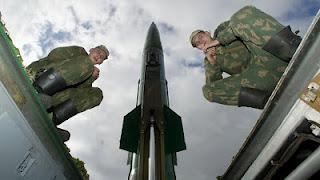 Over 400 modern ground- and sea-based ICBMs, 8 ballistic missile submarines, about 20 general purpose attack submarines, over 50 surface ships and some 100 military-purpose spacecraft, over 600 modern aircraft, including fifth-generation fighters, more than a thousand helicopters, 28 regimental sets of S-400 surface-to-air missile systems, 38 division sets of Vityaz air defense systems, 10 brigade sets of Iskander-M tactical missile systems, more than 2,300 modern tanks, some 2,000 self-propelled artillery systems and guns, and more than 17,000 military vehicles. These are the figures of the massive rearmament program announced by Russian prime minister Vladimir Putin in an article published on February 20 by state-owned newspaper Rossiyskaya Gazeta.
Over 400 modern ground- and sea-based ICBMs, 8 ballistic missile submarines, about 20 general purpose attack submarines, over 50 surface ships and some 100 military-purpose spacecraft, over 600 modern aircraft, including fifth-generation fighters, more than a thousand helicopters, 28 regimental sets of S-400 surface-to-air missile systems, 38 division sets of Vityaz air defense systems, 10 brigade sets of Iskander-M tactical missile systems, more than 2,300 modern tanks, some 2,000 self-propelled artillery systems and guns, and more than 17,000 military vehicles. These are the figures of the massive rearmament program announced by Russian prime minister Vladimir Putin in an article published on February 20 by state-owned newspaper Rossiyskaya Gazeta.
The article, titled “Being Strong is a Guarantee of Russia’s National Security,” shows Putin’s determination to preserve Russia’s deterrence power facing US plains aimed at achieving nuclear primacy. Since the collapse of the Soviet Union, the gap between Russia’s declining arsenal and US constantly improving systems is actually increasing to the point of making the age of MAD nearing an end. Nevertheless, Russian nuclear deterrent is still formidable, as Moscow can count on more than 2,000 operational strategic warheads deployed along the entire territory of the federation and the seas plowed by the submarines of the Russian Navy. But what is more, in case of nuclear crisis Russia can still rely on several top secret bases inherited by the Soviet Union, and not only.
Russia’s national command and control system is dispersed among different hardened underground locations. According to US sources, two of the main secret bases are located in the Ural Mountains, where conventionally European Russia ends and greater Siberia begins. The first one is the Yamantau Mountain complex. Located near the closed town of Mezhgorye, in the Republic of Bashkortostan, this site is not far from Russia’s main nuclear weapons lab facility, Chelyabinsk-70. Military analysts suspect that Yamantau’s huge 400-square-mile underground complex houses nuclear warhead and missile storage sites, launch control and several full-blown nuclear weapons factories designed to continue production after a hypothetical nuclear war begins.
THE YAMANTAU MOUNTAIN
 The second secret base in the Urals is an underground command and control center located at the Kosvinsky Mountain, about 850 miles east of Moscow. The site hosts the Russian Strategic Rocket Forces alternate command post, a deep underground command post for the general staff built to compensate for the vulnerability of older command posts in the Moscow region. The facility, finished in early 1996, was designed to resist US earth-penetrating warheads and is the Russian version of the American Cheyenne Mountain Complex.
The second secret base in the Urals is an underground command and control center located at the Kosvinsky Mountain, about 850 miles east of Moscow. The site hosts the Russian Strategic Rocket Forces alternate command post, a deep underground command post for the general staff built to compensate for the vulnerability of older command posts in the Moscow region. The facility, finished in early 1996, was designed to resist US earth-penetrating warheads and is the Russian version of the American Cheyenne Mountain Complex.
Besides Yamantau Mountain and the Kosvinsky Mountain underground complex, Russia can still count on the Sherapovo bunker site, south of Moscow. Initially built in the 1950s, it was the primary command center for the Soviet leadership. The Kremlin is connected to Sherapovo and other bunkers by a secret subway line. According to a 1988 Pentagon report, once at Sherapovo, the Soviet leaders could have conduct a nuclear war by sending orders and receiving reports through a highly redundant communications system. Russia’s general staff has a similar facility some 20 kilometers away from Sherapovo, known as Chekhov. Both sites can accommodate an estimated 30,000 people each one.
Although Russia has tried to keep secrecy about its underground bases, information about these sites have circulated anyway. According to a CIA report, “the command post at Kosvinsky appears to provide the Russians with the means to retaliate against a nuclear attack.” The construction of the facility has actually helped Moscow to counterbalance the decline of its nuclear forces following the end of the Cold War and the collapse of the Soviet Union. In this sense, the existence itself of top secret bases within the territory of the Russian Federation is the best means of deterrence against any first strike intention, and thereby a warranty to world peace.

